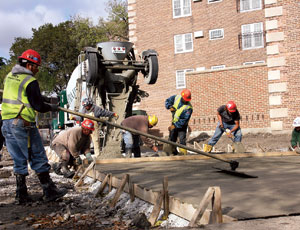Tom Commings needed a job. Over the past summer, the 35-year old resident of Dearborn Homes, a wornout, public-housing complex on Chicago’s South Side, was laid off from a factory job. Relief came this September in the form of a $28.2-million infusion of federal stimulus funds aimed at upgrading three of Dearborn’s 16 brick apartment buildings. Commings now is working as a laborers’ union Local 4 apprentice steps away from his front door. “It’s hard work, but it’s good work,” says Commings. “It’s a great opportunity.”


Built in 1950, Dearborn’s monolithic brick buildings originally were designed to contain 800 units. Decades later, the development had joined the city’s many failed housing projects. By the early 1980s, drug dealing and other criminal activity had infested the community, which was fraught with gang violence and blight. “It was hard to stay out of trouble,” says Commings.
As part of Chicago’s $1.5-billion plan to transform the city’s affordable housing stock into modern, self-sufficient communities, Dearborn’s $172-million gut rehab marks a new era in public housing. The total units will shrink to about 600 as floor plans expand. Units previously contained no showers or air-conditioning but now feature Corian tubwalls and permanent room air-conditioners. Each building will receive a new boiler and underground infrastructure. Outside, the previously austere buildings will receive new tuck-pointing, stone accents and landscaping.
| Jobs Created | Total: 500 Current: 200 |
|---|---|
| ARRA Contract Amount | $28.2 Million |
| Total Project Value | $172 Million |
The city is helping people by putting Dearborn residents on the job to gain new skills. “One objective is moving residents toward self-sufficiency and employment,” says Bill Little, executive vice president of development for the Chicago Housing Authority (CHA). “Given that we have these major construction projects ongoing, we obviously want to employ as many public-housing residents as possible.”
At Dearborn, Commings is one of a dozen “Section 3” employees, an economic opportunity under the Housing and Urban Development Act. As CHA residents must seek employment and pay rent according to an income schedule, Section 3 provides assistance. “They are trying to cut the freeloaders out,” says David Joyce, project superintendent for Burling Builders Inc. The locally based general contractor hired Commings and sponsored his two-year apprenticeship.
When about $1 billion of stimulus money poured into Chicago this past spring, CHA secured $143 million in formula funds and $66 million in competitive grants under the American Recovery and Reinvestment Act. “What the stimulus has essentially done is allow us to accelerate the schedule,” Little says. “Instead of finishing Dearborn in 2013, we are looking at 2011.” An average 200 workers are on the job now, with 500 needed in total, Joyce estimates.
Residents working on the stimulus phase, set to wrap up next month, will walk away with new skills. But staying employed will take determination. “Just because you work a couple of months with us doesn’t mean you are going to continue to work,” says Joyce. Commings’ apprenticeship is “an opportunity to learn a trade so he can support himself,” Joyce says.
Another resident, Angela Brown, 36, guards the gate and directs traffic. The work “keeps me fit [and] keeps food on my table,” says Brown, who plans to become a construction flagger. As for Commings, he is grateful the federal work is helping him get closer to journeyman status. “People have got to learn how to utilize the stimulus,” he says. “Let’s give this a chance and don’t be quick to knock it. Let’s see if this is going to work.”


Post a comment to this article
Report Abusive Comment